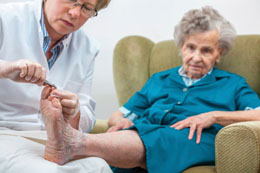Feet are invariably the most ignored body parts. However, it's essential to consult a podiatrist at the earliest for proper diagnosis of foot disorders. So, put your best foot forward to find more about when is the right time to see a podiatrist.

The podiatrists were earlier known as chiropodists. Lewis Durlacher was one of the notable chiropodists who provided treatment to Queen Victoria and many other important personalities. Podiatrists are doctors who deal with problems related to the feet and ankle. It is a general belief that problems associated with feet and ankle hardly turn serious and don't need special treatment. However, there are instances when it becomes necessary to consult a podiatrist for treatment. Pain, swelling, wounds and other such problems cannot be neglected and require medical treatment. Let us understand more about when to see a podiatrist and obtain information about the nature of work of these medical practitioners.
There are different medical conditions for which one needs to see a podiatrist. The following information will give you a rough idea of when you should see one.
Neuropathy
Neuropathy results from damage caused to peripheral nerves. Nerve inflammation is one of the symptoms of neuropathy. Numbness and loss of sensation that results from neuropathy makes it difficult to detect any injury caused to the feet. There are many different causes of neuropathy and some of them are malnutrition, diabetes and alcoholism. Although peripheral neuropathy cannot be cured completely, a podiatrist may suggest some treatment measures that can minimize the effects of this condition. Over-the counter creams are generally prescribed by doctors for treating neuropathy. Tingling sensation and feeling of numbness can be reduced with the help of these medications. Since, diabetes is the main cause of neuropathy, doctors also prescribe medications or dietary changes to keep the level of blood pressure in check.
Discoloration of Feet
The change in color of feet is an indicator of some disease. For example, in case of foot infection, reddish discoloration of feet would be observed due to swelling and increased blood supply to the affected part. The infection which results into cellulitis is caused by bacterial strains like the Streptococcus and Staphylococcus. Because of the infection, the pattern red coloration is observed in the form of blotchy patches on the skin. In case of inadequate blood supply, foot becomes pale in color. Sometimes, in venous insufficiency, the leg may turn purple or bluish.
Deformity
Bunion is a form of deformity observed in big toe. In this condition, the bone and the tissue at the junction of big toe becomes swollen. Bunions are hereditary and one should be able to take action by identifying it as early as possible. Bunions are treated by using footwear that puts pressure off the toes.
Soreness
Important causes of soreness in feet include high-impact exercises, fallen arches (flat feet), hammer toes (curling of toes into claw-shape) and use of shoes that don't fit properly. Soreness can originate in any part of the foot such as forefoot, toes or hindfoot. Commonly used treatment methodology for soreness is the R.I.C.E (Rest, Ice, Compression and Elevation). Physiotherapy in the form of stretching is also used for the treatment of soreness. Inspection of feet on a regular basis is one of the preventive measures for soreness. One should wear proper fitting insoles/shoes and wash the feet regularly to prevent occurrence of such problems.
Mole on Feet
Mole on feet is one of the reasons to consult a podiatrist. Some of the moles or 'nevi' (lesions) change their form in the course of time. This change in form is coupled with increase in the size. In some cases, the mole might start bleeding. Melanoma is suspected to be one of the causes of mole occurrence on feet; the melanoma is a skin cancer which results from multiplication of melanocytes.
Pain and Tenderness
The pain caused to feet can be of many different types. One might experience pain while walking due to various problems in the structure of musculoskeletal system. Spondylitis, heel spur, arthritis, plantar fasciitis are some of the common disorders that can cause symptoms in the foot, and cause of pain while walking. Medications and use of foot padding are recommended by podiatrists for the treatment of this type of pain.
Neglecting the symptoms or the common foot problems described above could lead to dangerous consequences. It is therefore, necessary to consult a podiatrist if you observe or find the signs and symptoms described in this article.


 The podiatrists were earlier known as chiropodists. Lewis Durlacher was one of the notable chiropodists who provided treatment to Queen Victoria and many other important personalities. Podiatrists are doctors who deal with problems related to the feet and ankle. It is a general belief that problems associated with feet and ankle hardly turn serious and don't need special treatment. However, there are instances when it becomes necessary to consult a podiatrist for treatment. Pain, swelling, wounds and other such problems cannot be neglected and require medical treatment. Let us understand more about when to see a podiatrist and obtain information about the nature of work of these medical practitioners.
The podiatrists were earlier known as chiropodists. Lewis Durlacher was one of the notable chiropodists who provided treatment to Queen Victoria and many other important personalities. Podiatrists are doctors who deal with problems related to the feet and ankle. It is a general belief that problems associated with feet and ankle hardly turn serious and don't need special treatment. However, there are instances when it becomes necessary to consult a podiatrist for treatment. Pain, swelling, wounds and other such problems cannot be neglected and require medical treatment. Let us understand more about when to see a podiatrist and obtain information about the nature of work of these medical practitioners.